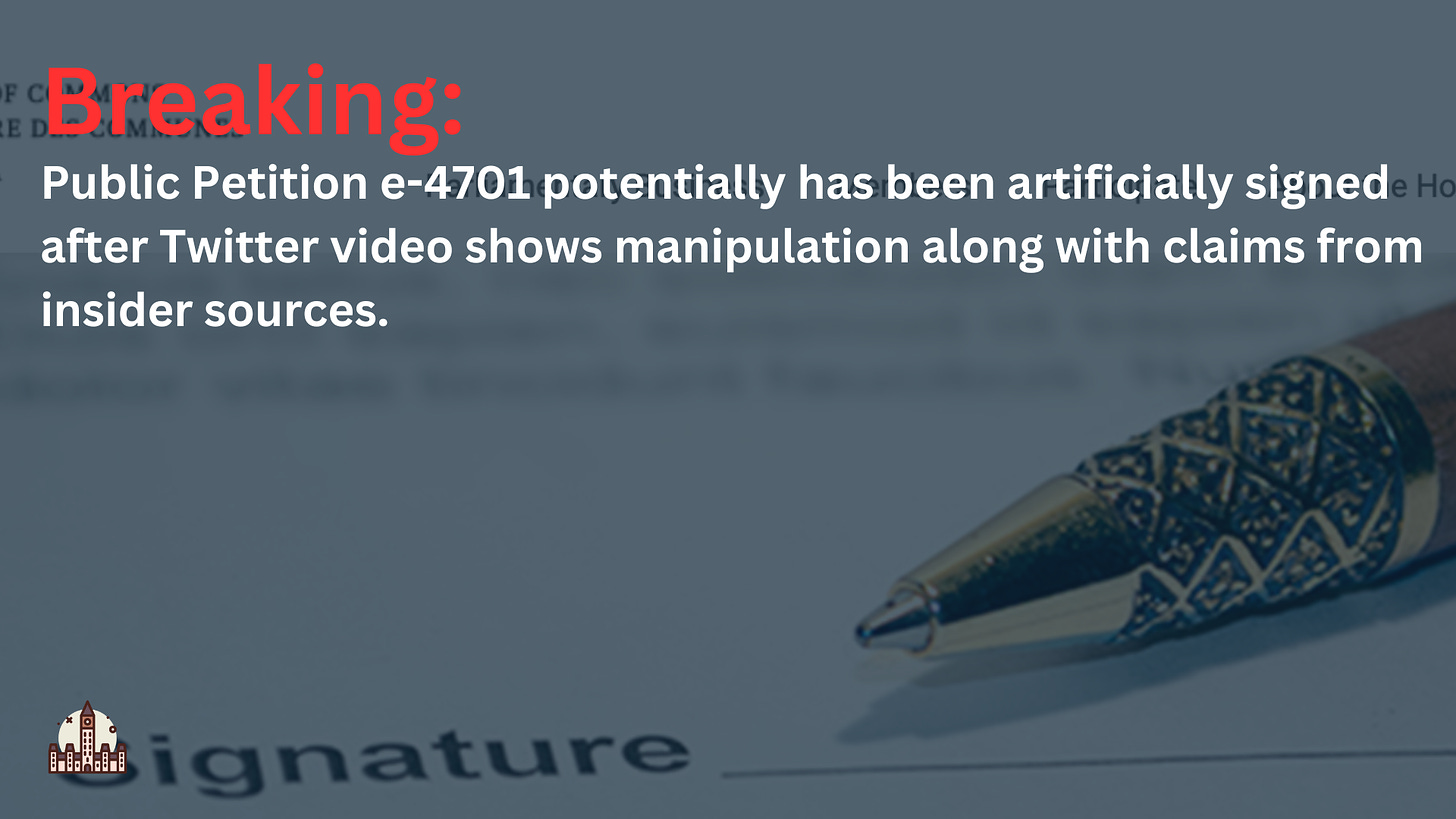BREAKING: Manipulation of signatures of Michelle Ferreri's Petition e-4701 appears to be possible.
Messages between users and videos have surfaced showing the manipulation
On the afternoon of December 14, 2023, as the petition asking the government to conduct a non-confidence motion surpassed 300,000 signatures, I received a private message from a prominent account in the Canadian convoy scene stating that the petition’s signatures are being manipulated to be higher than actual legitimate signatures.
The message consisted of the claim that a small but committed group of individuals is using email burner applications like “10 Minute Mail” and “Temp-Mail,” in addition to VPN applications, to circumvent the ability to only sign a petition once. For research purposes that will be shown in a later video tonight, I was able to sign the petition twice on the same device using these simple tactics. It’s important to note that we didn’t confirm the final signature, meaning the signature didn’t count. But we did verify this process is possible.
Twitter user @JanA55_D shows here how easy it is to manipulate the amount of signatures
This message and the account it is attached to appear to be legitimate in their claim and have been verified by a few others who were contacted about this claim. At the time of writing, the petition has 315,598 signatures. This accounts for roughly 0.07% of the Canadian population. We all know this petition does nothing, and it appears to be a tool that the farthest flanks of the Conservatives are using to garner support.
The troubling thing is that the ourcommons.ca website where the petition signing takes place states that only one signature per person can be done. This is clearly proven wrong by myself and others that it can be easily done through free-to-use applications on most smartphones.
After receiving this message and validating the claim and also finding other posts about people doing this very allegation, I reached out to the clerk who manages petitions, and they, to their credit, replied back very quickly. The reply email went as follows:
Hi JB,
Thank you for your email and for your interest in the House of Commons petitions.
Indeed, petition e-4701 is now the most signed electronic petition since the establishment of electronic petitions in 2015. There has been paper petitions reaching over 600,000 signatures in the past few decades, but the exact numbers are not on our website since we only started publishing the results of paper petitions (those that have been certified and presented) online in 2019.
As you probably know, in order to sign an e-petition, a signatory must be a Canadian citizen (living in Canada or abroad) or a resident of Canada, meaning that the person lives in Canada and can provide their full name, province or territory, postal code and phone number.
Only valid signatures are added to the total number of signatures for a petition. There are tools at the disposal of clerks of petitions to verify signatures and ensure the integrity of the signature process.
The House of Commons electronic petitions system was established in 2015 based on the guidelines set out in the 33rd report of the Standing Committee on Procedure and House Affairs, later concurred in by the House, available online at the following link:
Committee Report No. 33 - PROC (41-2) - House of Commons of Canada (ourcommons.ca)
The following extract from the report might be of interest to you:
The software used to manage e-petition signatures should safeguard the integrity of the e-petition process and flag issues or unusual patterns for spot-checks and verification. For example, the software could flag instances of signatures with the same first and last names; similar e-mail addresses; where a high number of signatories (e.g. ten or more) originate from the same IP address for the same e-petition; or it could flag a disproportionate number of signatories for the same e-petition originating from non-Canadian IP addresses. For greater certainty, this would not otherwise limit the ability of the Clerk of Petitions from taking other measures to monitor and verify the integrity of the e-petition process.
As for your question regarding access to signatures, the House of Commons is not subject to the federal Privacy Act and the Personal Information Protection and Electronic Documents Act, or provincial privacy legislation. That said, and as set out in the Electronic Petitions – Guide and Terms of Use (ourcommons.ca), “the House of Commons is committed to follow best practices related to the protection of personal information collected, used, disclosed, transmitted and preserved as part of the e-petition process.”
As further set out in the Electronic Petitions – Guide and Terms of Use (ourcommons.ca), “the House of Commons' authorized personnel will have access to the personal information of a petitioner, supporter and signatory, and may use it to contact them or to validate their identity to ensure the integrity of the e-petition process. Data may be used for statistical purposes.” The only information that can be accessed by third parties outside of the House of Commons is the information in the petition that is made publicly available – namely, the petitioner’s information, the number of signatories, and the province/territory of residence of the signatories.
Lastly, it should also be mentioned that all supporters' and signatories' personal information is destroyed no later than six (6) months after a petition becomes inactive, or earlier if the dissolution of Parliament occurs.
We hope this answer your questions.
I asked some follow-up questions in regards to reporting fraudulent signatures and how to obtain a copy of the signature. They have yet to respond. It appears the only people who have access to these signatures would be an MP or staff in the house, who would be required to keep that information private for the right reasons. We have reached out to a few MPs we are mutuals with to see if they can assist in any way.
We are unable to file an ATIP request for this information as the House of Commons is protected by Parliamentary privilege. The only ones who would have access to the raw data are someone with that privilege, and if they were to share it publicly, it would be breaking that privilege.
While I want to make it very clear that this is just an allegation about potential manipulation by a coordinated group of individuals, I, along with the people I contacted, have yet to confirm that this manipulation is taking place. At this time, it remains an allegation.
I am encouraging transparency here by writing this and looking into this story. We owe it to all Canadians to ensure our democratic institution is secure and unable to be manipulated. If we get any updates to this story as we continue to dig into it, we will update you all accordingly.
Until next time.






